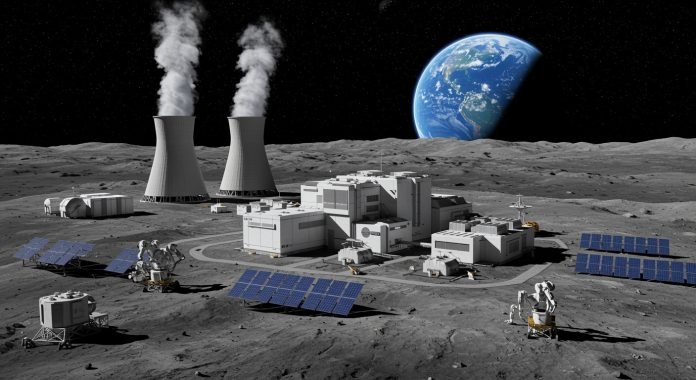New Delhi: The latest developments in space exploration reveal a rapid shift from symbolic achievements such as “flags and footprints” to long-term, sustainable infrastructure on extra-terrestrial bodies. One of the most ambitious proposals currently under discussion is NASA’s plan to establish a small nuclear reactor on the lunar surface by 2030.
This comes against the backdrop of China’s announcement in April 2025 of its intention to construct a lunar nuclear power plant by 2035 to support an international lunar research station. These announcements are not isolated but form part of a broader infrastructure race between space powers, where the ability to generate dependable energy on the Moon could define influence, access, and governance in the coming decades.
From a technical perspective, the reliance on nuclear energy is not unprecedented. Since the 1960s, both the United States and the Soviet Union deployed radioisotope thermoelectric generators (RTGs) that utilised small amounts of radioactive material to power deep-space missions, ranging from satellites and planetary rovers to probes like Voyager.
The unique lunar environment, however, poses challenges that solar energy alone cannot reliably solve. With nights lasting 14 Earth days, vast craters in permanent shadow, and the need for continuous operation of life-support and scientific systems, nuclear power promises a stable, long-term solution.
A compact reactor could provide consistent power for habitats, mining operations, rovers, 3D printing systems for in-situ construction, and communication systems critical for sustained human presence. More significantly, proving the feasibility of such power sources on the Moon would create essential technologies for future Mars missions, where solar energy is even less reliable.
Legally, the deployment of nuclear reactors in space is neither prohibited nor entirely new. The 1992 UN Principles Relevant to the Use of Nuclear Power Sources in Outer Space explicitly recognise the necessity of nuclear energy in environments where solar power is insufficient, while establishing guidelines for safety, transparency, and international consultation.
Similarly, the 1967 Outer Space Treaty (OST), which remains the cornerstone of international space law, prohibits territorial claims on celestial bodies but allows for installations such as bases and power facilities, provided they uphold principles of peaceful use and broad access.
Article IX of the OST further requires that nations act with “due regard to the corresponding interests of all other States Parties,” which means that once a reactor is established in a specific location, other countries would need to take its presence into account in their own activities.
While this does not amount to sovereignty, in practice it could shape norms around exclusion, accessibility, and legal interpretations of jurisdiction. In other words, whoever successfully deploys a lunar reactor first will likely set the standards for subsequent international behaviour in lunar operations.
The geopolitical implications are central to this issue. Nuclear power is not just about energy; it is about influence. By constructing infrastructure capable of supporting long-term scientific and commercial activity, a nation can strengthen its role as a gatekeeper for access to strategic areas. This is particularly relevant to the lunar south pole, where permanently shadowed craters are thought to contain water ice deposits.
These resources could be transformed into drinking water, oxygen for habitats, or even rocket fuel, making them vital to both exploration and commercial enterprise. A nuclear station positioned near such areas could effectively anchor facilities and thereby limit where others can operate, even if international law forbids outright ownership. This emerging scenario highlights the delicate balance between international cooperation and competition in space exploration.
Despite its potential, significant concerns remain. The risks of radiation leaks, accidents during launch, or operational hazards in the harsh lunar environment cannot be dismissed lightly. Critics fear that deployment of even small-scale reactors could cause long-lasting contamination or disrupt sensitive regions of scientific interest.
Nevertheless, stringent UN guidelines, as well as US safety frameworks developed with the Department of Energy, provide a roadmap toward mitigating these dangers through careful design, transparency, and open consultation. Experts stress that public confidence, international trust, and adherence to existing treaties will be crucial to ensuring that nuclear power fulfils peaceful purposes rather than exacerbating suspicion or rivalry.
The broader question, then, is not whether nuclear reactors on the Moon are legally permissible – they are – but how their construction and use are governed. If the United States commits to transparency, consultation under Article IX of the OST, and an open approach that encourages international cooperation, it will reinforce norms of peaceful use and accountability.
Conversely, secrecy and unilateralism risk fuelling an arms-race mentality that undermines long-term goals of shared exploration. In this sense, the challenge is not just technological but profoundly political and legal: building the infrastructure is easier than building the trust required to use it responsibly.
To summarise, NASA’s lunar nuclear reactor project represents a turning point in space strategy. It addresses the fundamental need for reliable energy in hostile extra-terrestrial environments, but at the same time positions the US in a race of infrastructure, influence, and governance with China and other spacefaring nations.
Far from violating international law, the project operates within existing legal frameworks, although the precedents it sets could reshape interpretation of laws governing outer space. While radiation safety and environmental risks remain real, adherence to international guidelines offers a pathway to minimising them.
Ultimately, the future of the lunar frontier will not be defined by who plants the most flags, but by who builds the infrastructure that enables sustainable presence. Nuclear power, if used responsibly, could become the foundation stone for humanity’s long-term expansion beyond Earth.






